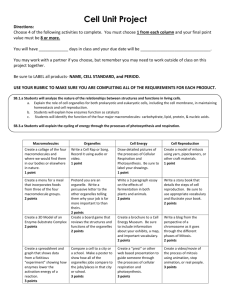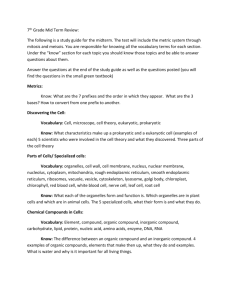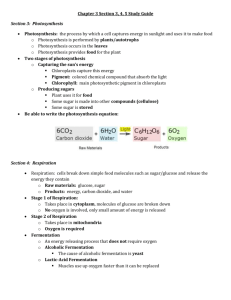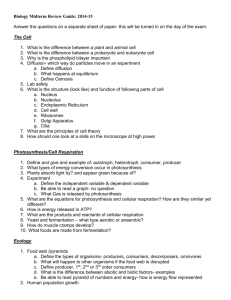Biology Midterm Review Guide: 2011
advertisement
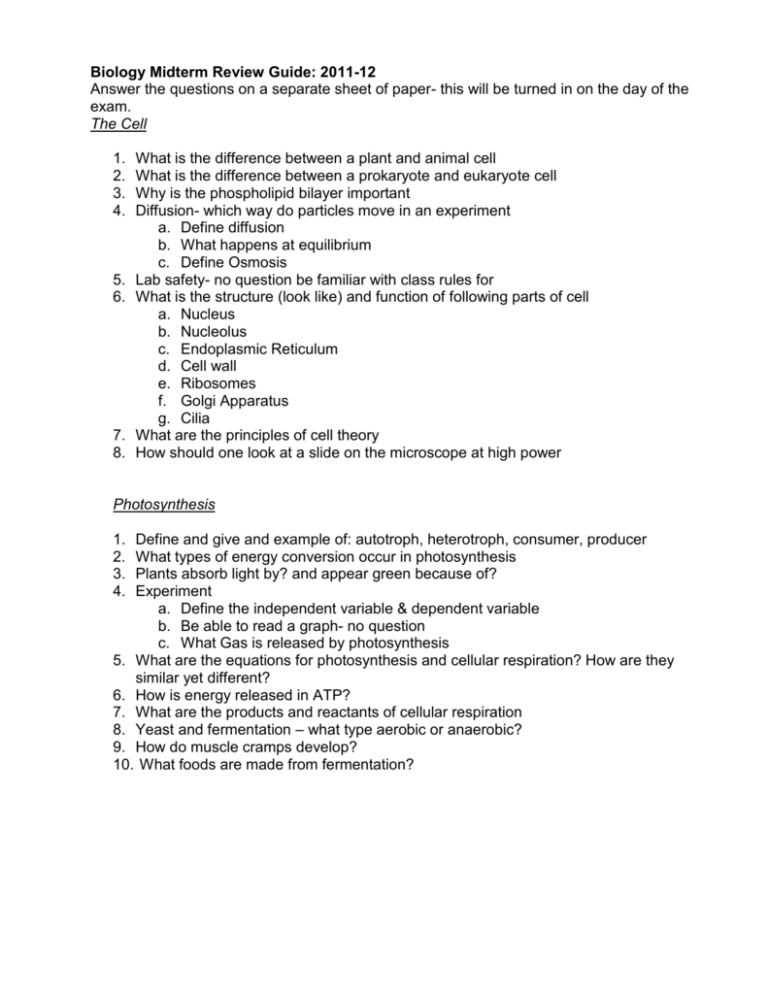
Biology Midterm Review Guide: 2011-12 Answer the questions on a separate sheet of paper- this will be turned in on the day of the exam. The Cell 1. 2. 3. 4. 5. 6. 7. 8. What is the difference between a plant and animal cell What is the difference between a prokaryote and eukaryote cell Why is the phospholipid bilayer important Diffusion- which way do particles move in an experiment a. Define diffusion b. What happens at equilibrium c. Define Osmosis Lab safety- no question be familiar with class rules for What is the structure (look like) and function of following parts of cell a. Nucleus b. Nucleolus c. Endoplasmic Reticulum d. Cell wall e. Ribosomes f. Golgi Apparatus g. Cilia What are the principles of cell theory How should one look at a slide on the microscope at high power Photosynthesis 1. 2. 3. 4. Define and give and example of: autotroph, heterotroph, consumer, producer What types of energy conversion occur in photosynthesis Plants absorb light by? and appear green because of? Experiment a. Define the independent variable & dependent variable b. Be able to read a graph- no question c. What Gas is released by photosynthesis 5. What are the equations for photosynthesis and cellular respiration? How are they similar yet different? 6. How is energy released in ATP? 7. What are the products and reactants of cellular respiration 8. Yeast and fermentation – what type aerobic or anaerobic? 9. How do muscle cramps develop? 10. What foods are made from fermentation? Cell Reproduction 1. Identify the phases of mitosis in picture form a. What is the correct order of mitosis phases? b. Which are longest? What occurs during interphase? 2. Define and Identify the centromere and sister chromatids 3. What are the number of human chromosomes in cell – body and sex cell 4. What is the purpose of karyotype 5. Define cytokinesis 6. Cancer cells a. How do they compare to normal cells b. What are treatments for cancer 7. What are the differences between mitosis and meiosis 8. Define: zygote, gametes 9. Diploid and Haploid number- define each and be able to calculate Written Response Questions Cell A Cell B Based on the cells above answer the following questions: Short Answer #1 (Two points) 1A) Identify each cell as plant, animal, or bacteria. 1B) Explain two differences between cell A and cell B. Short Answer #2 (Two points) 2A) Identify each cell as either prokaryotic or eukaryotic. 2B) Justify your choice for Cell A and Cell B based on the characteristics of prokaryotes and eukaryotes. Extended Responses #1 (Four points) 1A) Classify each cell as either a heterotroph or an autotroph. 1B) Based on your response in extended response 1A explain how does each cell obtains it energy. 1C) Which cell(s) carryout the process of cell respiration based on the organelle present. Explain. 1D) Which cell(s) carryout the process of photosynthesis based on the organelle present. Explain. Biology Midterm Review Guide: The Cell 1. What is the difference between a plant and animal cell Plant Animal Membrane and cell wall Plasma membrane Mitochondria and chloroplast Mitochondria Cytoplasm, nucleus Cytoplasm, nucleus Most organelles Most organelles 1. What is the difference between a prokaryote and eukaryote cell – prokaryotic lacks a nucleus and most other organelles - eukaryotic cell has a membrane bound nucleus and organelles 2. Why is the phospholipid bilayer important- regulates the transport of substances across it 3. Diffusion- which way do particles move in an experiment a. Define diffusion- net movement of the particles of a substance from where they are more concentrated to where they are less concentrated b. What happens at equilibrium- reached when the movement of particles in one direction is equal to the number of particles moving in the other c. Define osmosis- passive transport of water across a selectively permeable membrane 4. Lab safety- be familiar with class rules for: fire use, acid use, glass breakage 5. What is the structure (look like) and function of following parts of cell a. Nucleus: center of cell, circular; the part that houses the cell's genetic material in the form of DNA b. Nucleolus: ball-like mass of fibers and granules in a cell nucleus c. Endoplasmic Reticulum: may be smooth or rough ribbon-like; network of membranes within a cell's cytoplasm that produces a variety of molecules d. Cell wall: box like structure; strong wall outside a plant cell's plasma membrane that protects the cell and maintains its shape e. Ribosomes: small dot structures- cluster of proteins and nucleic acids that constructs proteins in a cell f. Golgi apparatus: flattened stack of ovals; cellular organelle that modifies, stores, and routes cell products g. Cilia: short structures projecting from a cell and containing bundles of microtubules that move a cell through its surroundings or move fluid over the cell's surface 7. What are the principles of cell theory - All living things are composed of cells, cells are the basic unit of structure and function in living things, cells come from pre-existing cells 8. How should one look at a slide on the microscope at high power: set in on low power and find the object, go to medium and then high keeping the organism in the center of the field of view, only use the fine adjustment on high power. Photosynthesis / Cell Respiration 1. Define and give and example of: -autotroph- organism that makes its own food; plant -heterotroph- organism that obtains food by eating other organisms; animal -consumer- gains energy from eating another organism -producer- an organism that makes its own food and produces organic molecules that serve as food for other organisms in an ecosystem 2. What types of energy conversion occur in photosynthesis: sun light into chemical energy 3. Plants absorb light by?pigments called chlorophyll and appear green because of? Chlorophyll / chlroplast 4. Experiment a. Define the independent variable & dependent variable Independent- the variable being manipulated; dependent- the variable that may change from the independent variable being manipulated b. Be able to read a graph c. What gas is released by photosynthesis: oxygen 5. What are the equations for photosynthesis and cellular respiration? How are they similar yet different? Cell respiration: 6O2 + C6H12O6 6CO2 + 6H2O + ATP Photosynthesis: 6CO2 + 6H2O + Solar Energy 6O2 + C6H12O6 6. How is energy released in ATP? When chemical bonds are broken between phosphates energy is released 7. What are the products and reactants of cellular respiration: in # 5. Products (outputs) are on left side of chemical equations, reactants (inputs) are on the left side 8. Yeast and fermentation – what type aerobic or anaerobic? Anaerobic because do not need oxygen 9. How do muscle cramps develop? Build up of lactic acid during fermentation in muscles due to lack of oxygen 10. What foods are made from fermentation? Cheese, alcoholic beverages, breads. Cell Reproduction 1. Identify the phases of mitosis in picture form a. What is the correct order of mitosis phases? Prophase, metaphase, anaphase, telophase, & cytokinesis b. Which are longest? Interphase between mitotic divisions What occurs during interphase? Cell grows, double chromosomes and organelles 2. Define and identify the centromere- place where sister chromatids are connected and sister chromatids- exact copies of the same chromsome 3. What are the number of human chromosomes in cell – body- 46 and sex cell- 23 4. What is the purpose of karyotype- A map of all the chromosomes in a body cell, can diagnose some genetic disorders before birth or during life. 5. Define cytokinesis- the cell divides the cytoplasm and organelles between the two daughter cells 6. Cancer cells a. How do they compare to normal cells- repoduce more rapidly, larger and use more nutrients b. What are treatments for cancer- surgery, chemotherapy, and radiation 7. What are the differences between mitosis and meiosis- mitosis creates exact copies of body cells (diploid); meiosis creates haploid sex cells 8. Define: zygote- form when fertilization of egg with sperm, gametes- sex cells (egg and sperm) 9. Define each and be able to calculate Diploid - # of chromosomes from mom AND dad and Haploid number-number of chromosomes from mom OR dad
